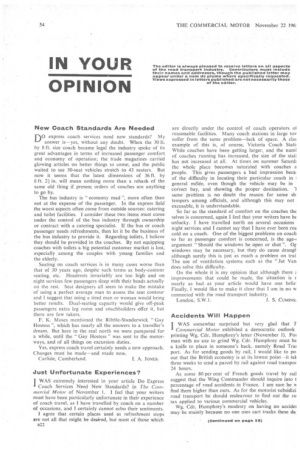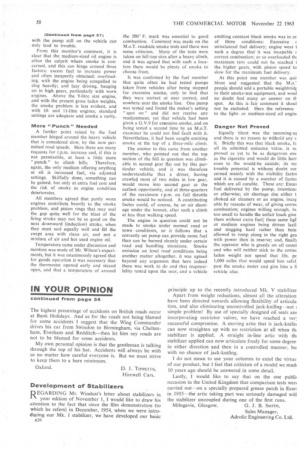IN YOUR OPINION
Page 56

Page 60

If you've noticed an error in this article please click here to report it so we can fix it.
New Coach Standards Are Needed JO express coach services need new standards? My
." answer is--yes, without any doubt. When the 30 ft. by 8 ft. size coach became legal the industry spoke of its great advantages in terms of increased passenger comfort and economy of operation; the trade magazines carried glowing articles on better things to come; and the public waited to see 30-seat vehicles stretch to 43 seaters. But now it seems that the latest dimensions of 36 ft. by 8 ft. 21 in. will mean nothing more than a rehash of the same old thing if present orders of coaches are anything to go by.
The bus industry is "economy mad ", more often than not at the expense of the passenger. In the express field the worst aspects often come from outside sources: catering and toilet facilities. I consider these two items must come under the control of the bus industry through ownership or contract with a catering specialist. If the bus or coach passenger needs refreshments, then let it be the business of the bus industry to provide it. Regarding. toilets, I believe they should be provided in the coaches. By not equipping coaches with toilets a big potential customer market is lost, especially among the couples with young families and the elderly.
Seating on coach services is in many cases worse than that of 30 years ago, despite such terms as body-contour seating, etc. Headrests invariably are too high and on night services few passengers sleep with their heads actually on the rest. Seat designers all seem to make the mistake of using a perfect average man to assess the seat contour and I suggest that using a tired man or woman would bring better results. Dual-seating capacity would give off-peak passengers extra leg room and coachhuilders offer it, but there are few takers.
F. K. Moses mentioned the Ribble-Standerwick "Gay Hostess ", which has nearly all the answers to a traveller's dream. But here in the real north we were pampered for a while, until the "Gay Hostess" was sent to the motorways, and of all things on excursion duties.
Yes, express coach travel certainly needs a new approach. Changes must be made—and made now.
Carlisle, Cumberland. I. A. JONES.
Just Unfortunate Experiences?
I WAS extremely interested in your article Do Express Coach Services Need New Standards? in The Commercial Motor of November 1. I feel that your writers roust have been particularly unfortunate in their experience of coach travel, as I have travelled by coach on a number of occasions, and I certainly cannot echo their sentiments.
I agree that certain places used as refreshment stops are not all that might be de.sired, but most of those which a22 are directly under the control of coach operators al reasonable facilities. Many coach stations in large toy suffer from the same problem—lack of space. A clas example of this is, of course, Victoria Coach Statil While coaehes have been getting larger, and the num' of coaches running has increased, the size of the stati has not increased at all. At times on summer Saturch the whole place becomes saturated with coaches a people. This gives passengers a bad impression becal of the difficulty in locating their particular coach in 1 general mêlée, even though the vehicle may be in correct bay, and showing the proper destination. same problem is no doubt the reason for some sh, tempers among officials, and although this may not excusable, it is understandable.
So far as the standard of comfort on the coaches the selves is concerned, again I feel that your writers have be unlucky. I have travelled north on several occasions night services and I cannot say that I have ever been rea cold on a coach. One of the biggest problems on coach so far as passenger comfort is concerned, is the age-o argument "Should the windows be open or shut ". Or windows may be necessary, but they do cause draugh although surely this is just as much a problem on trai The use of ventilation systems such as the "Jet Yen does solve this difficulty.
On the whole it is my opinion that although there improvements that could be made, the situation is r nearly as bad. as your article would have one belie' Finally, I would like to make it clear that I am in no w connected with the road transport industry.
London, S.W.1. J. S. CUMIN& Accidents Will Happen I WAS somewhat surprised but very glad that 7 I Commercial Motor exhibited a democratic outlook printing Wg. Cdr. Humphrey's letter (November 1). Fat man with no axe to grind Wg. Cdr. Humphrey must ha a knife to place in someone's back, namely Road Trai port. As for sending goods by rail, I would like to po. out that the British economy is at its lowest point—it tat three weeks to send a parcel by rail against road transpor 24 hours.
As some 80 per cent of French goods travel by rail suggest that the Wing Commander should inquire into t percentage of road accidents in France. I am sure he find them higher than ours. As for the motorist subsidizi road transport he should endeavour to find out the ro tax applied to various commercial vehicles.
Wg. Cdr. Humphrey's modesty on having no accidei may be mainly because no one uses cart tracks these da:
The highest precentage of accidents on British roads occur at Bank Holidays. And as for the roads not being blamed for some accidents I suggest that the Wing Commander drives his car from Swindon to Birmingham, via Cheltenham, Evesham and Redditch—then let him say roads are not to be blamed for some accidents.
My own personal opinion is that the gentleman is talking through the top of his hat. Accidents will always be with us no matter how careful everyone is. But we must strive to keep them to a bare minimum.
Oxford. D. J. TIPPETTS, Hirewell Cars.
Development of Stabilizers EGARDING Mr. Windust's letter about stabilizers in 1 I your edition of November 1, I would like to draw his attention to the fact that since the film demonstration (to which he refers) in December, 1954, when we were introducing our Mk. I stabilizer, we have developed our basic
B26
principle up to the recently introduced Mk. V stabilizes
Apart from weight reductions, almost all the alteration have been directed towards allowing flexibility of articula tion, and also eliminating uncontrolled jack-knifing--not ; simple problem! By use of specially designed oil seals and incorporating restrictor valves, we have reached a ver: successful compromise. A moving artic that is jack-knifed can now straighten up with no restriction at all when th, stabilizer is applied. A straight in-line artic with thi stabilizer applied can now articulate freely for some degree in either direction and then in a controlled manner, bu with no chance of jack-knifing.
I do not mean to use your columns to extol the virtue of our product, but I feel that criticism of a model we mach 10 years ago should be answered in some detail.
Lastly, I would like to say that on the one publii occasion in the United Kingdom that comparison tests wen carried out—on a specially prepared grease patch in Esse: in 1955—the artic taking part was seriously damaged witl the stabilizer uncoupled during one of the first runs.
Milngavie, Glasgow. G. J. B. SMITH, Sales Manager, Adrolic Engineering Co. Ltd.




































































































